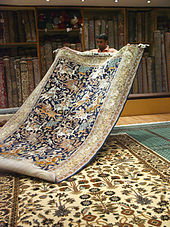Etymology and usage of rugs

Etymology and usage
The term carpet comes from Old French carpite. One derivation of the term states that the French term came from the Old Italian carpita, from the verb “carpire” meaning to pluck. The Online Etymology Dictionary states that the term “carpet” was first used in English in the late 13th century, with the meaning “coarse cloth”, and by the mid-14th century, “tablecloth, [or] bedspread”.The Online Etymology Dictionary states that the term comes “…from Old French carpite “heavy decorated cloth, carpet,” from Medieval Latin or Old Italian carpita “thick woolen cloth,” probably from Latin carpere “to card, pluck,” probably so called because it was made from unraveled, shred[d]ed, “plucked” fabric”. The meaning of the term “carpet” shifted in the 15th century to refer to floor coverings.
The term “carpet” is often used interchangeably with the term “rug”. Some sources define a carpet as stretching from wall to wall.Another definition treats rugs as of lower quality or of smaller size, with carpets quite often having finished ends. A third common definition is that a carpet is permanently fixed in place while a rug is simply laid out on the floor. Historically, the term “carpet” was also applied to table and wall coverings, as carpets were not commonly used on the floor in European interiors until the 15th century.
The term “rug” was first used in English in the 1550s, with the meaning “coarse fabric”. The term is of “…Scandinavian origin; compare Norwegian dialectal rugga “coarse coverlet,” from Old Norse rogg “shaggy tuft,” from Proto-Germanic *rawwa-, perhaps related to rag (n.) and rough (adj.).”The meaning of “rug” “…evolved to “coverlet, wrap” (1590s), then “mat for the floor” (1808)”.


 Free Delivery Anywhere in Canada
Free Delivery Anywhere in Canada